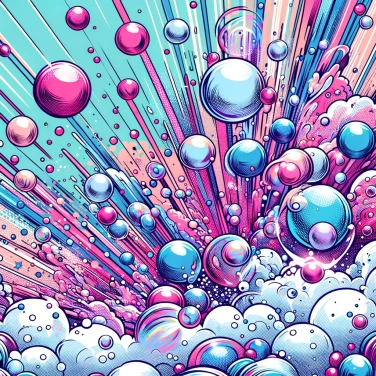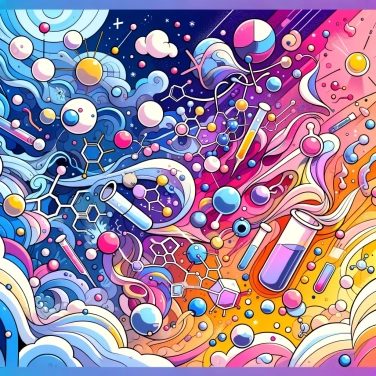Soap bubbles burst after a certain time because the liquid they are made of evaporates gradually. When the liquid layer becomes too thin, it can no longer retain the air pressure inside the bubble, causing it to burst.

Soap bubbles are made up of a thin film of water, soap, and air. Over time, the water they contain gradually evaporates into the surrounding air. As a result, the wall becomes thinner and more fragile. As this layer of water thins, the bubble loses its elasticity and eventually bursts. The drier the air, the faster the water disappears—accelerating the premature demise of your beautiful colored bubble.
Surface tension is a bit like an elastic skin on the surface of soapy water, which allows the soap bubble to exist. But this phenomenon is a fragile balance: over time, when the bubble starts to lose water through evaporation or drainage, certain areas quickly become thinner. These spots lose elasticity and become unstable. As a result, the forces of surface tension can no longer maintain the balance; they pull too hard in some places, and the bubble eventually bursts. In other words, surface tension both helps and hastens the inevitable end of the soap bubble.
Soap bubbles appear fragile, and they truly are: even the smallest bit of dust suspended in the air is often enough to trigger their bursting. These tiny impurities, dirt particles, or pollen grains discreetly settle on the bubble's surface. The result: these little intruders disturb the stability of the thin liquid layer by locally altering its surface tension balance. The weakened bubble then quickly cracks, as the soap film can no longer maintain its initial perfect cohesion. The more the surrounding air is loaded with impurities, the faster the bubbles tend to burst.
Ambient temperature plays a significant role in the lifespan of a bubble. At higher temperatures, the water present in the liquid film of the bubble evaporates quickly. As a result, the bubble becomes so thin and fragile that it eventually bursts unexpectedly. Conversely, a cooler temperature reduces evaporation, allowing the bubble to maintain its liquid film intact for a longer time. However, be careful, as too cold is not ideal either: excessive cold can make the thin film of water stiffer and more sensitive to even the slightest contact. In short, for a soap bubble to survive as long as possible, it needs a moderate temperature, neither too hot nor too cold.
When a soap bubble floats in the air, its liquid naturally begins to flow downward due to gravity. Gradually, this thin layer of soapy water becomes thinner at the top and thicker at the bottom. As a result, the upper walls of the bubble progressively thin out until weak points appear, particularly sensitive to breakage. As soon as this ultrathin layer reaches a critical threshold, the slightest variation, even a tiny one, is enough to cause the bubble to burst immediately. This phenomenon called drainage explains why, even in the absence of other external disturbances, any bubble inevitably ends up bursting.
At very low temperatures, close to freezing, bubbles can freeze and maintain their shape for several hours, thus forming beautiful visible crystallization patterns.
The official world record for the largest soap bubble ever created dates back to 2015, with a volume exceeding 96 m³, which is large enough to contain a small vehicle inside!
The iridescent colors observed on a soap bubble come from the phenomenon of light interference. The light reflected by both sides of the thin soap wall creates these beautiful, ephemeral rainbows.
The recipe for a durable soap bubble generally includes glycerol or sugar syrup to slow down the evaporation of water and enhance the stability of the film.
The heat accelerates the evaporation phenomenon of the water present in the bubble’s membrane, quickly thinning it out, which leads to a faster weakening and, consequently, a premature bursting of the bubble.
Theoretically, under strictly controlled conditions (optimal composition, constant temperature, maximum humidity, and complete absence of impurities or vibrations), a bubble could last a very long time. However, no bubble can actually last forever due to multiple environmental factors that are practically impossible to control completely.
To extend the lifespan of the bubbles, use a well-balanced soap solution, occasionally add glycerin or sugar to increase viscosity, favor a humid air environment, and avoid sudden temperature changes or dusty surroundings.
Not necessarily. Although a sharp surface does indeed facilitate the rupture of the membrane, bubbles generally burst on their own after a certain amount of time, due to the gradual evaporation of water, the drainage of liquid under the influence of gravity, or impurities present in the air.
The iridescent colors of bubbles come from light interference. When light hits the thin wall of the bubble, it reflects off the two surfaces of the thin layer of soapy water. These interferences depend on the thickness of this liquid layer, creating these beautiful ephemeral colors.
The lifespan of a bubble depends on several factors: the precise composition of the mixture (concentration of soap and water), the ambient temperature, the humidity of the air, and even the absence of impurities in the environment. The more optimal these conditions are, the longer a bubble is likely to last.

0% of respondents passed this quiz completely!
Question 1/4